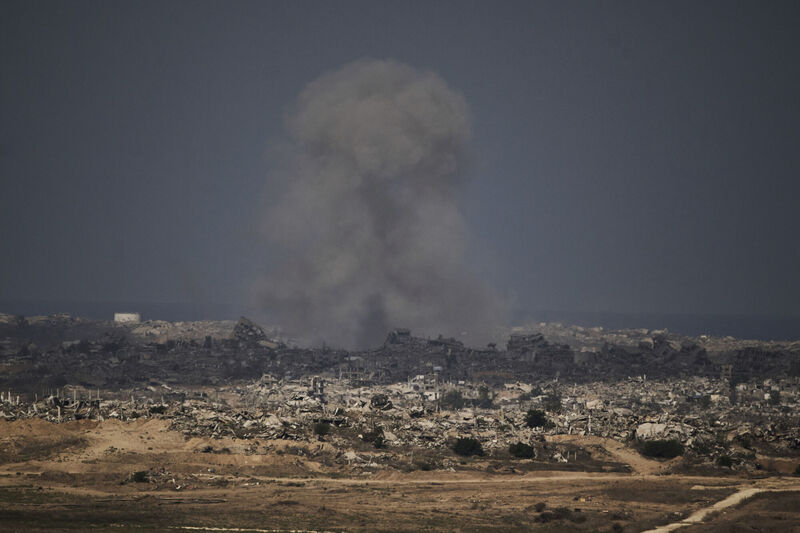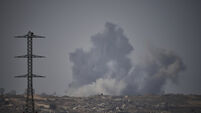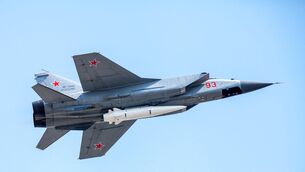Civilians made up 15 of every 16 people killed by Israel in Gaza since March, data suggests

Palestinians mourn their relatives who were killed in an Israeli military strike on Gaza, during their funeral in al-Shifa hospital in Gaza City. File picture: Jehad Alshrafi/AP
About 15 of every 16 Palestinians the Israeli military has killed since its renewed offensive in Gaza began in March have been civilians, data collected by the independent violence-tracking organisation Acled indicates.
The civilian death rate implied by a report from Acled, which stands for Armed Conflict Location and Event Data, is one of the highest recorded during the conflict, and will increase international pressure on Israel as its forces advance into Gaza City, forcing up to a million people to evacuate and threatening further large-scale civilian casualties.
Researchers from Acled, which is backed by western governments and the UN, tracked reports of losses sustained by Hamas and allied armed groups in Gaza from the Israeli military, reliable local and international media, statements from Hamas and other sources over a six-month period.
“Since 18 March, Israel claims it killed more than 2,100 operatives, though Acled data indicates that the number is closer to 1,100, and includes Hamas’ political figures, as well as fighters from other groups,” the report said.
More than 16,000 Palestinians have been killed since Israel broke a two-month ceasefire in March with a huge wave of airstrikes across the devastated territory, according to statistics published by the UN.
Military officials briefed the 2,100 figure to Israeli media in mid-August and internal Israeli estimates may have risen since. Acled’s researchers may also not have captured all combatant deaths over the six-month period, but their total does include Hamas political figures.

revealed last month that internal data from the Israel Defense Forces (IDF) indicated a civilian death toll of 83% between the outbreak of war in October 2023 and May of this year.
The Acled report also found that incidents involving the demolition of buildings in Gaza had increased significantly since the renewal of hostilities in March, with 698 in the 15 months before, and 500 in the six months since. Many incidents involved more than one building, researchers said.
A senior Israeli military officer told last week that there was “a tension” between protecting civilians and the “demands of fast-moving military operations”.
“We are fighting a very different war from any previous conflict anyone has fought anywhere in the world,” they said. “There are strict rules of engagement but what has changed is the policy that was designed for small wars where we wanted to deter [enemies] … We are now fighting in Gaza to ensure that Hamas is not ruling Gaza.”
The IDF said on Friday that it would operate with “unprecedented force” in Gaza City, urging residents to flee southwards while announcing the closure of a temporary evacuation route opened 48 hours earlier.
Acled said Israeli airstrikes had killed at least 40 commanders and key operatives in Hamas’s military wing since March. Only one senior official from Hamas’s pre-war military council is still in command, the report noted.
“Hamas has been weakened undoubtedly and does not think they can now stop or defeat Israel and push them out of Gaza through military force,” said Ameneh Mehvar, Acled’s senior analyst for the Middle East and a co-author of the report. At this point Hamas is trying to “preserve what is left” of the movement”, he added.
The monthly number of Hamas clashes with Israeli forces has declined sharply since the end of the ceasefire as it relies more on booby-trapped buildings and roadside bombs to cause casualties.
Four Israeli soldiers were killed by a roadside bomb in Rafah this week, bringing the number killed since March to 54.
Mehvar said that although small cells of fighters were scattered across much of Gaza, Hamas was now largely limited to Gaza City and the central town of Deir al-Balah, with some presence in al-Mawasi, the undeveloped and overcrowded coastal area where hundreds of thousands of Palestinians have been ordered to go by Israeli forces.

“These are areas where [Israeli forces] are not operating so logically that is where Hamas would be present. Hamas do obviously hide among civilians, but also in areas where there are none,” said Mehvar.
The Israeli offensive in Gaza has killed more than 65,000 people, mostly civilians, and injured more than 160,000 since October 7, 2023. Swathes of the territory have been reduced to ruin, and almost 90% of homes damaged. Health services have collapsed and expert UN-backed monitors declared famine in the north last month.
The war was triggered by a Hamas incursion into Israeli during which it killed 1,200 people, mostly civilians. It also took more than 250 hostages back to Gaza, of whom 50 remain, though fewer than half are thought to still be alive.
The Acled report said there was no evidence of Hamas systematically stealing aid that was delivered to Gaza by the UN as alleged by Israel, but that some assistance distributed by smaller NGOs might have been diverted by the organisation, which took power in Gaza in 2007.
“Israel has created conditions of chaos and violence around aid distribution,” the report said. “At the same time, looting has sharply increased. The pattern of looting shows no evidence of Hamas’ systematic involvement. Hamas has probably diverted aid through other mechanisms and can continue to do so as long as it retains domestic influence.
“With little prospect of eliminating Hamas entirely, [Israel’s] government is pursuing a long-term strategy of control: degrading Hamas while blocking alternative Palestinian governing arrangements, pushing Gaza toward unliveable conditions to encourage voluntary emigration and ultimately obstructing any path to Palestinian sovereignty.”










